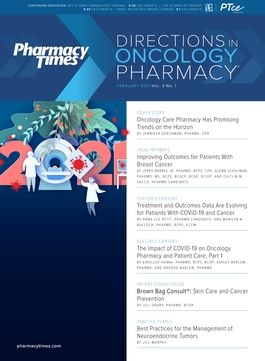Publication
Article
Pharmacy Practice in Focus: Oncology
The Role of Telehealth in Oncology Pharmacy Is Increasingly Important
Author(s):
“Digital medicine and its regulation are constantly evolving, which is a great thing.”—Betsy Cernero, PharmD
Technology can help drastically improve disease monitoring, management, and diagnoses, according to clinical pharmacists. Wearable technology and apps for monitoring health and wellness have increased in popularity, and virtual health services are demonstrating that telehealth can be just as effective as in-person visits with pharmacists.1,2
Experts on digital health care at the virtual 2020 American Society of Health-System Pharmacists (ASHP) Midyear Clinical Meeting and Exhibition presented data and information on evolving health technology in 2 sessions. They illustrated how pharmacists could use this technology in oncology.1,2
According to presenter Betsy Cernero, PharmD, an ambulatory care clinical pharmacist at NewYork- Presbyterian Hospital in New York, New York, wearable technology and apps that monitor health and wellness have exploded in popularity and sophistication in recent years.
“Digital medicine and its regulation are constantly evolving, which is a great thing,” said Cernero.1
She said the 21st Century Cures Act helps accelerate the development, approval, and review of such products and the Health Insurance Portability and Accountability Act regulates the information that is transmitted or stored on apps and devices.1
Although wearable devices that monitor our health, such as self-blood pressure monitors for cardiology conditions and continuous glucose monitors for individuals with diabetes, are making massive strides in digital health technology, wearable devices that administer medication are also gaining traction. Patients adhere to 50% of the drugs prescribed for chronic disease in developed nations, according to the presentation by Cernero and Carolyn J. Oxencis, PharmD, BCOP, BCPS, a clinical oncology pharmacist and clinical assistant professor at Froedtert & the Medical College of Wisconsin in Milwaukee. Wearable drug delivery devices, sometimes called bolus injectors or on-body infusers, can help increase medication adherence, Cernero said.1
The technology has proved especially beneficial for those living with cancer. For example, in 2015, the FDA approved a device for pegfilgrastim that decreased the incidence of infection in patients with nonmyeloid malignancies who received myelosuppressive anticancer drugs associated with a clinically significant incidence of febrile neutropenia. The device is a single-use-on-body infuser with a prefilled cartridge. The provider loads the device, which delivers a 45-minute at-home self-injection approximately 27 hours after application.1
In another ASHP session, a panel of experts moderated by John Beyer, PharmD, MS, MBA, BCPS, a pharmacy informatics manager at the University of Iowa Health Care in Iowa City, and LaTasha Riddick, PharmD, a clinical coordinator at Johns Hopkins Home Care Group in Baltimore, Maryland, opined that telehealth offers patients an interactive, cost-effective way of seeing a health care provider remotely using video and audio technology.2
Prior to the coronavirus disease 2019 pandemic, telehealth was largely seen as optional and was primarily used during particular circumstances. However, the pandemic has made telehealth an invaluable service, as it offers patients a safe way to speak to their health care providers.2
“Traditionally, these [telemedicine services] have been focused on inpatient pharmacy services, such as order verification for hospitals that are either located in rural communities or are extensions of a larger health system,” said Beyer. “And many times, pharmacists would provide cognitive services such as being a resource to nursing staff, or provider staff…or other types of clinical monitoring. We’ve now seen a much larger expansion into the outpatient space.”
Despite the benefits of health technology, barriers still exist. One barrier may include patient confusion on how the technology works. According to Oxencis, a lack of integration into electronic health records also exists. Low-income patients or patients with low health literacy may also not have access to needed technological devices.1
Additionally, all of the factors relating to medication adherence are not fully addressed in most digital applications. A reliance on self-reporting may also impact results.1
“So, barriers to using any of these apps, of course, are…ease of use and cost,” Oxencis said. “What do these apps look like, and are they actually helpful?”
According to Cernero and Oxencis, technology and medicine have continued to merge in recent years. Pharmacists should be integrating health technology in their routine clinical practice for maximum optimization.1
REFERENCES
- Cernero B, Oxencis, C. Don’t worry, be “appy”: when tech meets medicine. Presented at: 2020 ASHP Midyear Clinical Meeting and Exhibition; December 6-10, 2020; virtual.
- Beyer, J, Riddick, L. “Siri, get me my pharmacist”: the virtual health pharmacist role. Presented at: 2020 ASHP Midyear Clinical Meeting and Exhibition; December 6-10, 2020; virtual.







